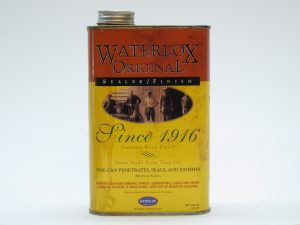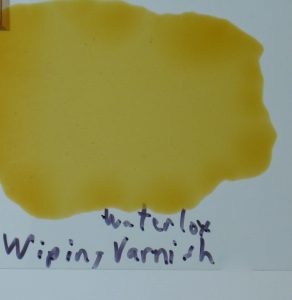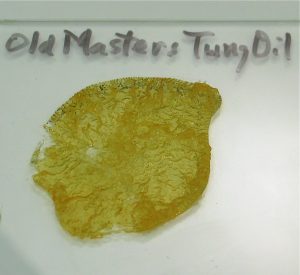We may receive a commission when you use our affiliate links. However, this does not impact our recommendations.

A can of Waterlox.
We have to have a common language or we can’t communicate. As I’ve written before, manufacturers of finishing products, especially those targeting amateurs and small-shop professionals, are notorious for their mislabeling (to use a nice word). Though the problem of confusion in finishing begins with the manufacturers, woodworking magazines and those who teach or write about finishing should not be let off the hook. They should be held responsible if they are contributing to the confusion.
Recently, I came across a video on Youtube of a furniture restorer repairing a Danish Hans Wegner chair from the 1960s. The repair was an especially difficult one and I thought the restorer did a good job. But near the end of the video he applies a finish to the arms of the chair and identifies it as tung oil. But the picture at minute 11:47 shows clearly that he’s using Waterlox. And Waterlox is varnish, specifically a phenolic resin/tung oil varnish.
Most varnishes are made with alkyd resins and soybean oil, so Waterlox is different. But it makes no more sense to call it tung oil because it’s made with tung oil than it would be to call bread “yeast” because it’s made with yeast or an airplane “wings” because it has wings.

This is a puddle of Waterlox, dried hard on glass.

This is a puddle of tung oil, dried soft and wrinkled on glass.
Not being accurate in the use of language, even when it’s the manufacturer that is responsible for the misidentification, can, and often does, lead others to use a finish that doesn’t produce the same results. I have two thoughts about this.
First, many years ago I was repairing a Danish teak chair and I needed to make a new part. I made it from teak, and because it was “common knowledge” that this type of furniture was finished with “teak oil” I dutifully used teak oil. (I wrote about teak oil in the Feb., 2015 issue of Popular Woodworking, #216, and I highly recommend you read this article to understand how manufacturers have totally confused this finish.) But it didn’t look right. It was much too flat and too dark. Of course, this was because the Danes didn’t use teak oil. They used catalyzed lacquer.
Second, Waterlox has long been thought of as tung oil. This is because the owner of the company has told people from at least as long ago as 1982 that Waterlox was tung oil. He told me the same in the several conversations I had with him. But on two separate calls to the company I managed to talk to the technicians who made the finish and both technicians (identified as “chemists”) confirmed what I had already determined, that Waterlox was indeed varnish.
The irony of the video was that the restorer was actually using a finish (one that would dry hard, so it could be built into a film with thickness) that was closer to what had actually been used on the chair originally!
Here are some supplies and tools we find essential in our everyday work around the shop. We may receive a commission from sales referred by our links; however, we have carefully selected these products for their usefulness and quality.









I also find that the misleading names perpetrated by the finish manufacturers to be a real problem. Tung oil and the many products with that phrase in the name is one of the leading ones.
I’m a particular fan of Tom Johnson’s YouTube channel. While he doesn’t spoon feed the information, he’s not stingy with it.
Bob Flexner’s deep knowledge, clear writing, and candid assessments are a great asset to the woodworking community and an important reason for my continuing subscription to Popular Woodworking.
If one would look long enough through their web site, there is as far as I could find, exactly one place where they come clean about their product. Then promptly go off on a tangent. Every other place talks about “tung oil finish.” I have used your bread/yeast example many times. I also got a kick out of Arm-R-Seal described as an “Oil – Urethane blend” like bread is a “Yeast – Flour blend.” Quote from Waterlox.com
” We view our Waterlox Original Tung oil finishes as varnishes, and while many make untrue product claims, Waterlox has never made any claims that we manufacture anything but a varnish. Our varnish is however a truly unique blend of Tung oil and resin that showcases the natural beauty of wood, providing lasting, durable protection. It is also truly different than other types of varnishes because it penetrates and builds up to a film that protects.”